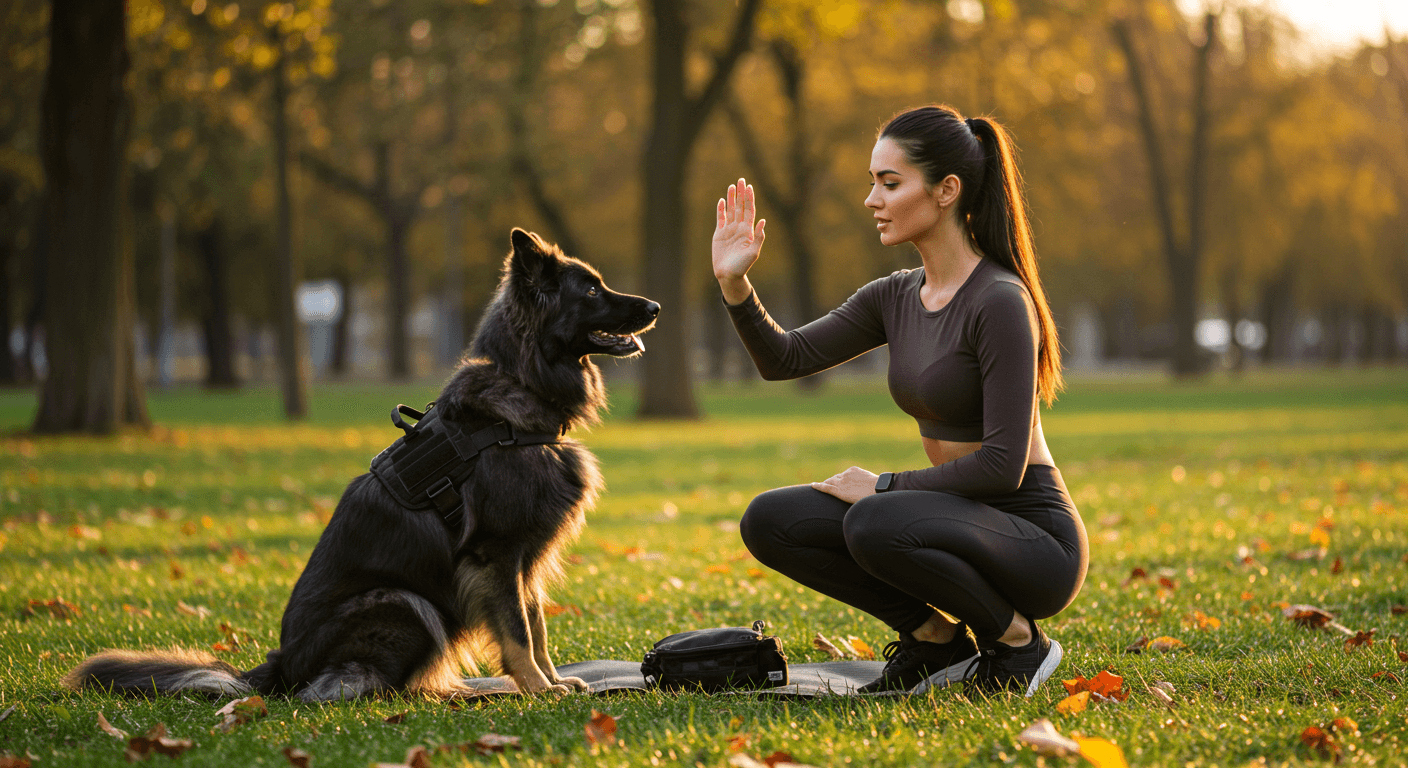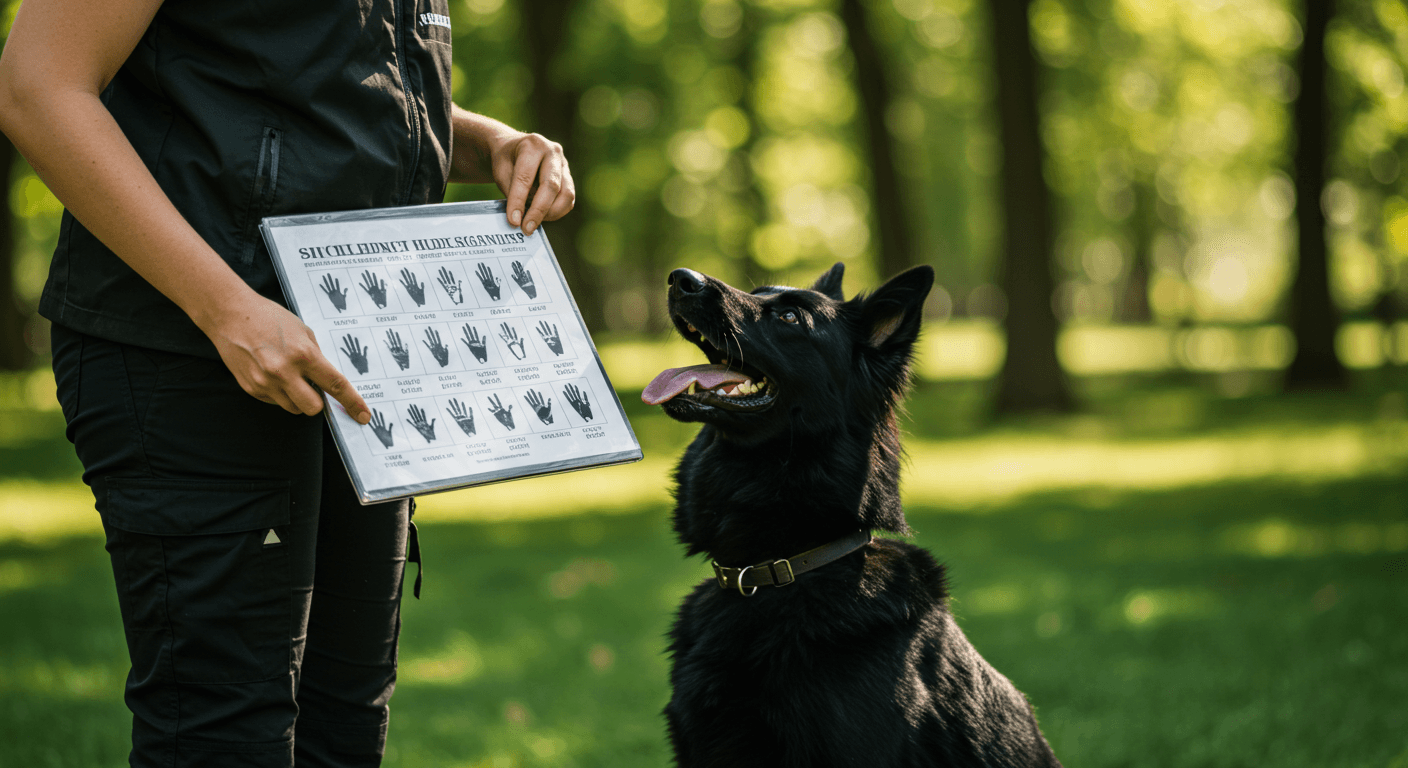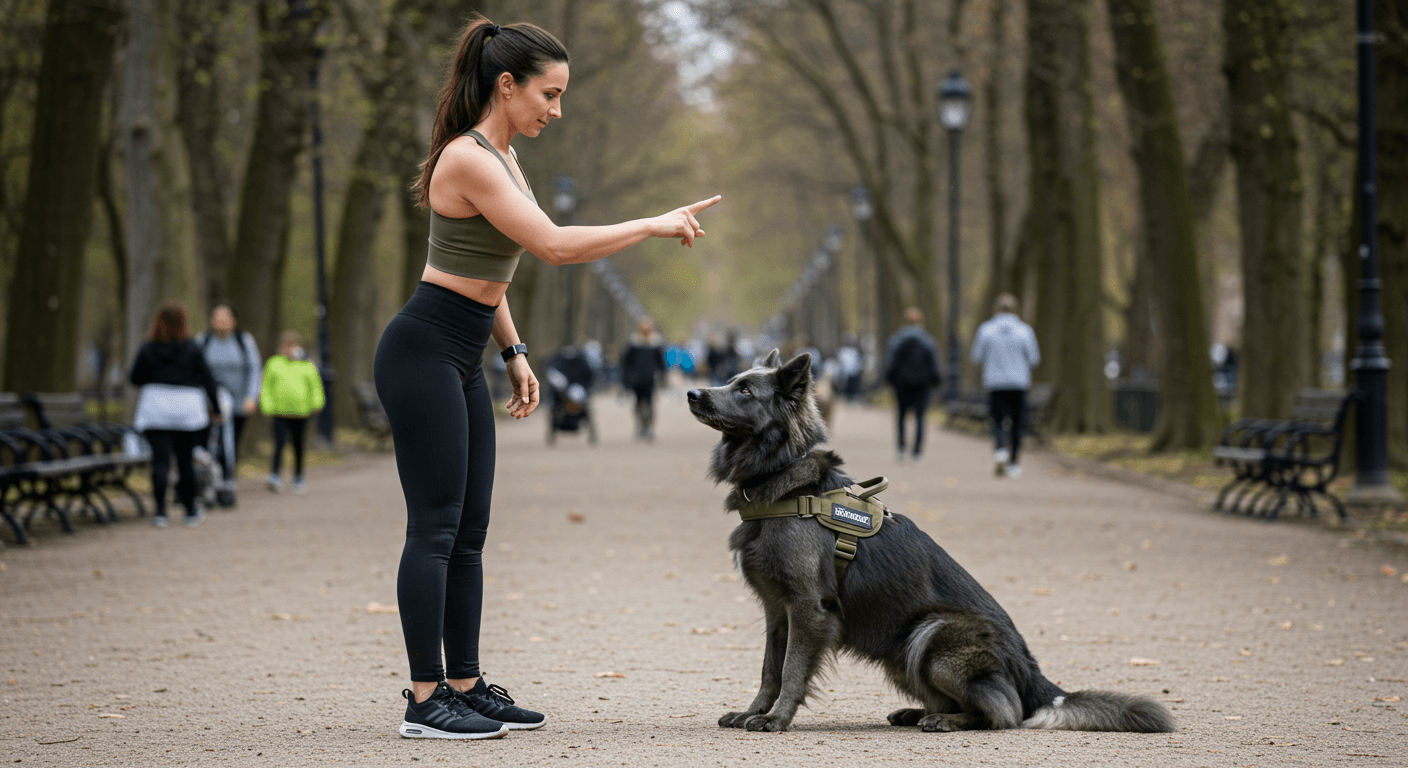If you’ve ever wondered whether dogs understand more than just words, you’re not alone. German Shepherd owners, in particular, know that their smart and loyal companions can pick up on so much more including body language. That’s where dog training hand signals come in.
Using hand signals for dogs isn't just a cool trick, it’s an effective way to communicate clearly and calmly with your pup. Whether you're teaching a new puppy, training an adult dog, or working on advanced obedience skills, hand signals can make a big difference. They are especially helpful in noisy environments or when your German Shepherd isn’t wearing a leash.
This ultimate guide to dog training hand signals will walk you through each step to help your German Shepherd understand exactly what you want all without saying a word. From basic cues like 'sit' and 'stay' to more advanced commands, we’ll cover everything you need to know.
Plus, we’ll explain why puppy training hand signals work so well for the German Shepherd breed. They're highly intelligent, eager to please, and tuned in to your body movements, making them quick learners when it comes to dog hand signals.
Get ready to be surprised by just how easy and fun it can be to use simple hand gestures to train your dog. Let’s dive in and give your German Shepherd the chance to shine!
Why Use Dog Training Hand Signals?

Did you know that dogs often respond faster to visual cues than spoken words? This is especially true for intelligent breeds like the German Shepherd. Using hand gestures for dog training taps into how dogs naturally understand the world through body language and movement.
Dogs pay close attention to what we do. That’s why dog training using hand signals can be so effective. Unlike voice commands that can get lost in a noisy park or muffled indoors, hand gestures are quiet, clear, and to the point. This helps your German Shepherd stay focused on you, even with distractions around.
Another big reason to use canine hand signals is to strengthen communication. German Shepherds are known for their strong bond with their owners. Teaching dog command hand signals creates a silent language between you and your dog. This builds trust, cooperation, and understanding.
- Helps dogs learn faster – German Shepherds are visual learners and respond well to motion.
- Great in noisy environments – Hand signals work when voice commands can’t be heard.
- Supports deaf or older dogs – Perfect for dogs with hearing issues but good eyesight.
- Builds stronger focus – Visual commands help dogs pay closer attention to you.
In short, adding hand gestures for dog training is not just a fun trick. It’s a powerful tool that can make life easier for both of you. When used consistently along with voice commands, these dog training hand signals can help your German Shepherd become more obedient, confident, and connected to you.
How to Teach Dog Hand Signals
Teaching your German Shepherd dog hand signals is easier than you think. In fact, with just a few hand movements and patience, your pup can learn to understand what you mean no words needed! Dogs, especially breeds like German Shepherds, are incredibly smart and respond well to visual cues. That’s why learning how to teach dog hand signals can be a game-changer for better obedience and a deeper bond.
Before you begin, pick a quiet spot with limited distractions. Your dog should be calm and ready to focus. Using a treat pouch or small reward is helpful for encouraging your furry friend to follow the signal and stay excited about learning.
- Pick a simple hand signal for each command – For example, a flat hand moving downward can mean "sit," while a palm facing forward can signal "stay." Choose signals that are easy to repeat and see clearly.
- Pair the hand signal with a verbal command – Say “sit” while doing the sit signal. This helps your German Shepherd connect them faster.
- Reward right away – Give a treat and lots of praise the second your dog follows the hand signal. Timing is everything!
- Practice short sessions – Just 5 to 10 minutes a day is enough. Keep it fun and always end on a happy note.
- Repeat and stay consistent – Use the same signal for each action every time. With regular training, your dog will learn in no time!
Using hand signals for dog training can also come in handy during loud situations or when your dog is far away. Whether your German Shepherd is in the backyard or at the park, hand commands help you stay connected without shouting.
Once your dog knows the basics, you can explore even more dog hand signals for advanced tricks or tasks. Always be patient and make training positive. Remember your German Shepherd loves learning from you!
How to Teach Hand Signals and Positions to Your Dog?
The Most Effective Dog Training Hand Signals

Training your German Shepherd with hand signals can be a game-changer. These dogs are smart, loyal, and love to learn. Using a clear list of dog commands and hand signals helps build trust and makes communication easier even from a distance.
Many German Shepherd owners find that hand signals work even better than verbal commands, especially in noisy or outdoor settings. It's like teaching your dog a secret sign language made just for the two of you!
Below is a simple and effective list of dog commands and hand signals. These work great for adults and puppies alike. Whether you're doing puppy training hand signals or teaching an older dog new tricks, these hand moves help get the job done fast.
- Sit – Raise your hand, palm up, then slowly move it upward. This tells your dog to sit.
- Stay – Hold your hand out, palm facing your dog, like a stop sign. Keep it still.
- Come – Extend your arm and then pull it toward your chest. This signals your dog to come closer.
- Down – Point your index finger to the floor in a steady motion. Use this when you want your German Shepherd to lie down.
- Heel – Tap your side with your hand as you walk forward. It tells your dog to walk beside you.
- No or Leave It – Wave your hand from side to side. This acts as a gentle warning.
Training with hand commands for dogs not only makes your dog smarter but also helps in real-life situations. For example, during walks or trips to the park, visual cues often work better than words especially from a distance.
Start with just one or two signs and practice every day for a few minutes. Be patient, reward positive behavior, and always use the same signal for each command. Pretty soon, your German Shepherd will be reading your hands like a pro!
Printable & Visual Resources

Having a visual guide can make teaching dog training hand signals much easier, especially if you're working with a smart and eager-to-learn German Shepherd. In this section, we'll explore printable and visual tools that help both you and your dog learn faster and stay consistent.
A popular and helpful resource is the dog training hand signals chart PDF. This kind of chart shows common signals for dog commands like 'sit', 'stay', and 'come'. It gives you a quick reference when you’re practicing at home or in the park. It’s even more helpful if you're working with a deaf dog, as hand signals are their main way of “hearing” you.
Visual learning tools are also great for kids or first-time dog owners. Seeing the motion matched with the command makes it easier to repeat. Plus, German Shepherds are super observant dogs they often pick up visual cues faster than words alone!
There are several types of hand signals for dogs, and while there's no universal set, most charts cover core commands. You can even print a custom dog command hand signals chart with just the signals you use most. Keeping this in your training space helps everyone in the home give your GSD the same signals, which avoids confusion.
If you're looking for a free or printable guide, search for a downloadable dog training hand signals chart PDF online. Laminate it for durability and hang it near your dog's crate, leash station, or common training area. It's a simple tool, but it makes a big difference with consistent training.
- Quick Reference – Easy to glance at during training sessions
- Consistency – Keeps all family members on the same page
- Customization – Add your own commands or hand signs
- Better Focus – Great for visual learners like German Shepherds
Hand Signals for Deaf Dogs
Training a deaf German Shepherd might sound tough at first, but it’s easier than you think. One of the best ways to connect and communicate with a deaf dog is by using clear, consistent hand signals. These hand gestures allow you to replace spoken commands with visual cues, making training both fun and effective.
A well-organized deaf dog hand signals chart can help guide you through the process. By teaching your GSD sign language-style commands, you're opening up a whole new world of understanding without the need for sound.
Think of dog sign language commands like human signs. They’re simple, repeatable, and easy for your dog to recognize. With regular practice, your German Shepherd will associate each hand movement with a specific action like sit, stay, or come.
- Sit – Hold your palm up like a stop signal.
- Stay – Show your open palm and take a step back.
- Come – Motion your hand toward your chest.
- Down – Point towards the ground slowly.
- No – Firmly wave your index finger side to side.
These hand commands for dogs are easy to remember and even easier to teach with treats and repetition. Use the same signs every time, and reward your GSD’s efforts. Over time, they’ll start to rely on your hands to guide them.
When choosing hand gestures for dog training, stay consistent. Switching signals can confuse your pup. And practice in a quiet spot where they can see your hands clearly like a fenced yard or calm living room.
If you’re just getting started, printing out a deaf dog hand signals chart can really help. It acts like a cheat sheet so your dog (and you) stay on the same page during training sessions.
When to Use Hand Signals vs Verbal Cues

Dog training using hand signals isn’t just fun it can be a powerful way to bond with your German Shepherd. But you might wonder when it's better to use hand signals instead of verbal commands. Knowing the right time and situation can make dog training more effective and even more enjoyable.
Verbal cues are great when your dog is close by and can hear you clearly. They're ideal for casual settings, everyday commands like “sit” or “stay,” and for building good manners quickly. However, verbal commands aren’t always enough especially in noisy environments or when your German Shepherd is far away.
That’s where dog training using hand signals really shines. Visual commands work wonderfully in parks, agility training, off-leash areas, or even inside a house when you want to communicate silently. German Shepherds are especially great at picking up on body language because they’re smart and attentive.
So when should you rely on hand signals for dog training? Here are some perfect moments:
- Loud environments: Dogs may not hear clearly, but they can see your hand signals from a distance.
- Long distances: Great for off-leash training or playing fetch in large spaces.
- Reinforcing focus: Canine hand signals help improve eye contact and engagement.
- Working dogs: GSDs in service or guard roles often respond better to clear visual cues.
- Hearing-impaired dogs: Hand signals are essential when verbal commands aren't an option.
Combining both verbal and visual commands is also an excellent idea. First teach your German Shepherd with both at the same time. Later, you can drop your voice and use hand signals alone for quiet communication or fun training games.
At the end of the day, the best choice depends on your training goals and your dog’s needs. Trust your instinct, pay attention to your GSD’s reactions, and have fun experimenting with different techniques.
Dog training hand signals can be a game-changer, especially for smart and strong-willed breeds like German Shepherds. By using simple body motions instead of just words, you build better focus, trust, and understanding with your loyal friend.
Throughout this guide, you've learned how to use hand signals for dogs from the basics like sit and stay to more advanced cues that can even surprise other dog owners. These non-verbal commands help your GSD respond faster and stay calm, even in noisy or distracting places.
Training with signals works best when paired with patience and praise. Whether you're just starting out or fine-tuning skills, be sure to keep sessions short, fun, and filled with treats and encouragement. Your German Shepherd will thank you with loyalty and love.
By choosing to teach dog hand signals, you're giving your GSD the gift of clearer communication. Over time, these cues become part of your bond, making walks safer, playtime better, and obedience smoother.
Now it's your turn pick 2 or 3 dog command hand signals to start with today. Repeat them daily, give cheerful rewards, and watch your GSD light up with confidence. Training isn’t just about control it’s about connection.



